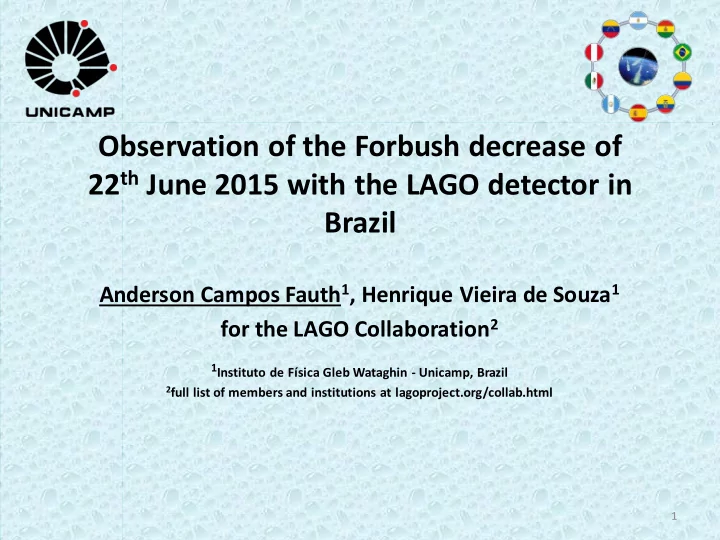

Observation of the Forbush decrease of 22 th June 2015 with the LAGO detector in Brazil Anderson Campos Fauth 1 , Henrique Vieira de Souza 1 for the LAGO Collaboration 2 1 Instituto de Física Gleb Wataghin - Unicamp, Brazil 2 full list of members and institutions at lagoproject.org/collab.html 1
What is LAGO? • The Latin American Giant Observatory (LAGO) is an extended cosmic ray observatory composed of water-Cherenkov detectors (WCDs) placed throughout Latin America • The study of the space weather through the solar modulation of galactic cosmic rays • A collaborative and non-centralized network of institutions from ten countries (Argentina, Bolivia, Brazil, Colombia, Ecuador, Guatemala, Mexico, Peru, Venezuela and Spain) • 28 institutions, 113 members • Developments, expertise and data are shared across the LAGO network 2
The LAGO sites The LAGO collaboration uses single or small arrays of detectors located at different altitude sites and covering a large range of geomagnetic rigidity cut-offs 3 Geomagnetic rigidity cut-off (GV)
Some LAGO detectors Chacaltaya, Bolivia Merida, Venezuela Guatemala Sierra Negra, Mexico Antarctica, by Argentina Campina Grande, Brazil Bariloche, Argentina 4
What is TANCA? TANCA is a nickname for the TANk detector of CAmpinas, the LAGO water-Cherenkov detector at University of Campinas, Brazil. University of Campinas South Atlantic Anomaly TANCA Campinas, SP, Brazil 22º 54’ S, 47º 03 N 650 meters a.s.l. 5
The TANCA detector • 3 PMT 9” Photonis XP1805 • Liner Tyvek • 11400 liters of pure water • Area vertical = 10 m 2 Water level height Muon pulse 1.14 m Voltage-divider, HV Photonis XP1805 power supply 50ns; 10mV 6
The TANCA DAq CAMAC/NIM modules: LeCroy Scaler 2551 (100 MHz); Logic Unit CAEN; Discriminator CAEN; Dual Gate Generator LeCroy 2323A; DAC CAEN Precise (0.02sec) gate for the 1 sec time interval of the counts, future GLE detection? HV1=1075V HV2=1125V; HV3=1250V; Limiares: L=-22mV; TC=300ns ms CK S1 S2 S3 D12 D13 D23 TRI 2016 08 30 00 00 00 039 1472515200039 Atmosferic M 2016 08 29 23 56 1 2016 08 29 20 50 941 23.1 48.8 0.0 23.9 135 0.0 01 1472515201125 4996 2136 2174 2372 1860 1911 1924 1813 date every 1472515202170 4996 2024 2055 2263 1727 1768 1817 1682 7 10 minutes 1472515203215 4996 2143 2199 2404 1882 1902 1965 1830
TANCA muon count efficiency Two small, 40x38cm 2 , plastic scintillators used to select vertical muons (95.7 ± 0.8) % Vertical muon (VM) 𝜗 = 𝑊𝑁 + 𝑢𝑏𝑜𝑙 threshold = -30 mV 𝑊𝑁 Pulse amplitude histogram Trigger: an other PMT The three PMTs calibrated to with a threshold of have the same gain 15mV 8
Barometric coefficient The flux of muons depends on the barometric pressure and this correlation can be approximated with an exponential behavior 𝐽 = 𝐽 0 𝑓 −𝛾(𝑄−𝑄 0 ) 𝑒𝑂 𝑂 = − 𝛾 𝑒𝑄 𝑂 ln = − 𝛾 𝑄 − 𝑄 0 𝑂 0 𝛾 = (0.108 ± 0.06)%/𝑛𝑐𝑏𝑠 The Forbush analyses are done with data corrected by the barometric coefficient. 9
TANCA registered a Forbush decrease June 2015 Coronal Mass Ejections Toward the Earth Five CMEs detected by SOHO/LASCO . WSA-Enlil simulation of the three first CMEs. CME score board : NASA GSFC Community Coordinated Modeling Center (CCMC), https://kauai.ccmc.gsfc.nasa.gov/CMEscoreboard/ 10 CME list : https://cdaw.gsfc.nasa.gov/CME_list/UNIVERSAL/2015_06/univ2015_06.html
Dst, Kp and TANCA during Forbush event The CMs and its magnetic interactions generated a strong geomagnetic storm The dashed vertical lines shows the CMEs arrivel time on Earth. Dst=-204nT Kp=8 The Dst index correlates well with the Kp=6 TANCA variations in muon counts. 11
Forbush detection by TANCA, McMurdo and Auger Scaler Mode The McMurdo neutron monitor is located at the Southh Pole and has a very low geomagnetic cut-off. The Auger Scaler Mode (single particle technique) is 15 minutes time averaged data from the Pierre Auger Observatory surface detectors. It is placed at Malargue, Argentina 12 McMurdo and Auger Scaler Mode correlate well with the TANCA result.
Summary • The TANCA detector is installed, calibrated and now is taking data continuously • The TANCA is detecting Forbush decreases and a new step will be analyzing these events together with others LAGO detectors • The TANCA detector is ready to detect a future muon short – term GLE • LAGO collaboration is helping a regional integration in Latin America • Using this WCD Brazilian students are learning about muon decay, detector physics and interaction of radiation with matter 13
Thank you for your attention Anderson Fauth fauth@g.unicamp.br We acknowledge the Pierre Auger Observatory, the University of Delaware and the Kyoto University for their open data policy making their data freely available through their web sites This work is supported by FAPESP, CNPq and Unicamp. 14
Extra slides 15
LAGO sites 16
Recommend
More recommend